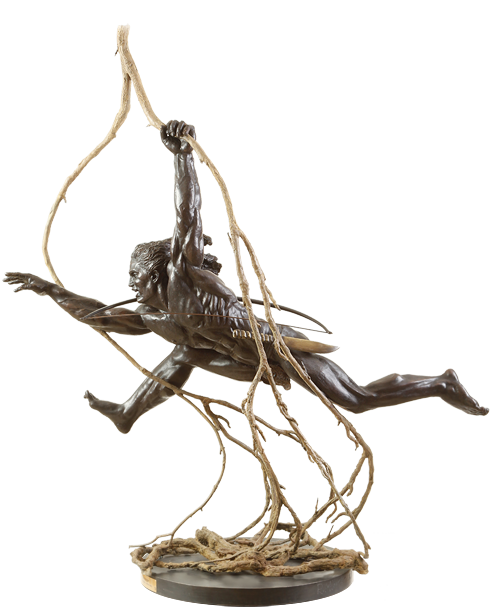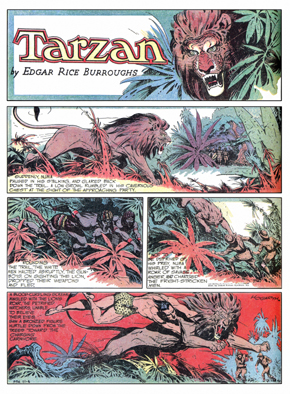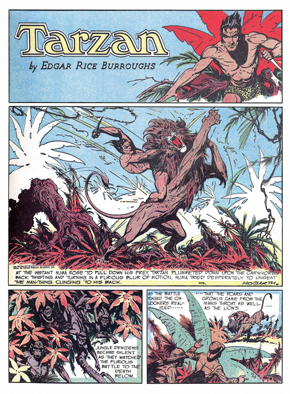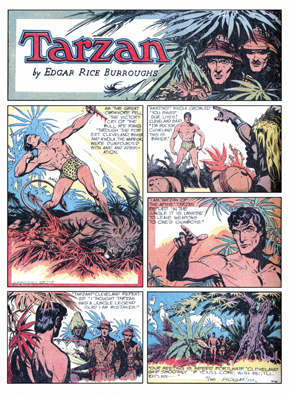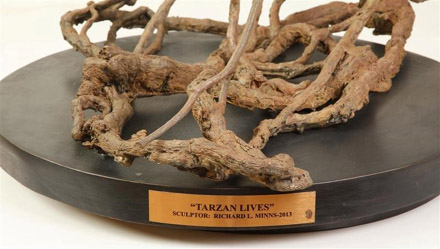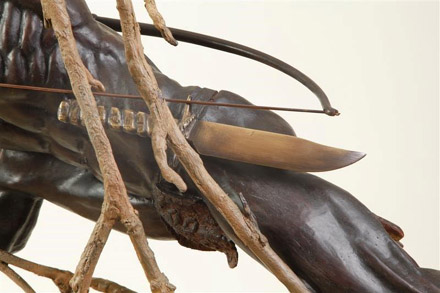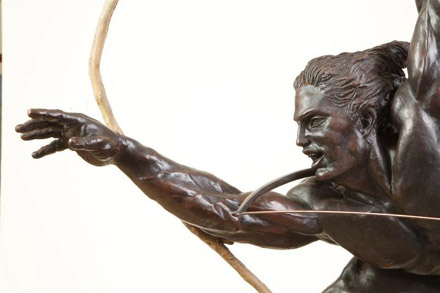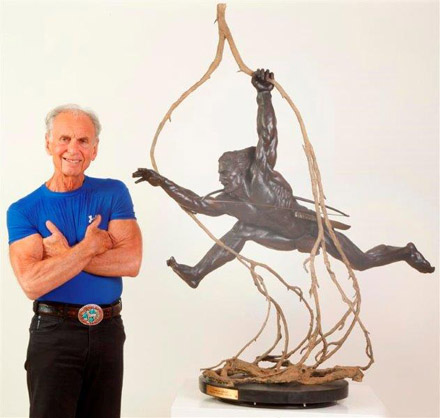 home
about
artists
exhibitions
press
contact
purchase
home
about
artists
exhibitions
press
contact
purchase |
|||||||||
|
RICHARD L. MINNS
Tall bronze on two circular
bronze bases. THE TARZAN LEGACY: ORIGIN OF “TARZAN, KING OF THE APES” Tarzan, the surviving just-born infant son of shipwrecked and deceased British Lord and Lady Greystock, was adopted, nursed and raised by a large female Ape to replace the infant son she had just lost. Tarzan, growing up in a tribe of Great Apes, became “King of the Apes” and “Lord of the Jungle”. Tarzan was created by the American novelist / writer Edgar Rice Burroughs and first appeared in Burroughs’ 1912 novel “Tarzan of the Apes”, over 100 years ago. The book was an instantaneous success, establishing Tarzan as the world’s most popular hero, from his creation in 1912 to this present day, dominating 23 sequential Tarzan novels, over 60 silent and sound films, animation, animé, stage, radio, television and video games. TARZAN LIVES! EDGAR RICE BURROUGHS’ 24 TARZAN NOVELS Edgar Rice Burroughs wrote 23 sequel Tarzan novels from 1912 through 1949. His books have been even more popular with adults and children than any other novelist, including J. K. Rowling’s Harry Potter Series. TARZAN MOVIES (1918 – 2014) Following the 1912 publication of “Tarzan of the Apes”, the first Tarzan movie by that name was launched in silent film in 1918. Eight Tarzan silent film feature movies followed from 1918 to 1928. Thereafter, over 48 Tarzan full feature sound movies were produced and viewed by packed cinemas. Many actors have played Tarzan (Elmo Lincoln, Lex Barker, Buster Crabbe, Gordon Scott, Jock Mahoney, Mike Henry and Ron Ely, to name a few). But the Olympic 5-time-gold-medalist swimmer Johnny Weissmüller made Tarzan his trademark, starting with “Tarzan the Ape Man” (1932) co-starring Maureen O’Sullivan as “Jane”. Weissmüller starred as the “Ape Man” in a total of twelve Tarzan films from 1932 through 1948, making him the most famous and longest-lasting screen Tarzan. Weissmüller’s yodel-like “Tarzan Yell” (the Victory Cry of the Bull Ape) became so associated with the character that it was dubbed into later films featuring different actors in order to make them “believable”. Warner Brothers and producer Jerry Weintraub have had a new Tarzan live-action film in development since 2003 and it is expected to be produced in 2014. TARZAN LIVES! A number of derivative full feature foreign language Tarzan productions are currently rolling out from Spain, China, Turkey, India and the Philippines. TARZAN LIVES! Weissmüller's famous "Tarzan Yell"
(audio sequence extracted from one of Weissmüller's Tarzan movies) RADIO AND TELEVISION Tarzan has been and remains the hero of many popular radio programs (now over 1,000 radio programs) and has been a primary television force for the past 100 years. TARZAN LIVES! TARZAN ANIMATION AND ANIMÉ Disney’s animated Tarzan (1999) marked a new beginning for the Ape Man followed by the Japanese Animé “Jungle, no Quja Ta-chan” (King of the Jungle Ta-chan) series. TARZAN LIVES! TARZAN COMICS Tarzan has also dominated the comics for almost 100 years. Tarzan became the immediate hero of United Feature Color Sunday Comics decades before other comic heroes (Superman, Batman, Spiderman, etc.) were conceived and before DC and Marvel Comics (Iron Man, Hulk, Thor, etc.) was even born. Hal Foster, the famous Canadian illustrator who changed the face of comics with his Prince Valiant series, was selected by Burroughs to depict his Tarzan. Foster put his mark on Tarzan from 1929 to 1936. Then, in 1936, the great unsurpassed illustrator and master anatomist Burne Hogarth undertook to draw Tarzan. At this time, Tarzan, the “Lord of the Jungle”, had already been in existence for 22 years in the novels of Edgar Rice Burroughs; he had been a character in the movies for 20 years; he had been a comic strip hero for 18 years. A student of Michelangelo and the great Baroque artists, Hogarth brought his illustrator’s skills and anatomical mastery to establish a new lasting image of Tarzan for United Features and the world, raising the level of comics to an art form. TARZAN LIVES! “They say it is never too late to have a happy childhood. So, pushing age 84 this 17 August, I am now enjoying my second childhood.” “As I get older, I go back to the days of my youth and my wonderful memories of Edgar Rice Burroughs’ Tarzan, the gripping cliff hanger Johnny Weissmuller black-and-white movies with his classic Tarzan Yell, Burne Hogarth’s pace-setting anatomical Tarzan comic strips, and even Walt Disney’s contemporary Tarzan animation.” “My TARZAN is young, muscular, slim. He is airborne, defying gravity as he soars through the trees swinging from vine to vine, long hair wild and flowing, exuberant with his mouth wide open as he gives his famous Tarzan yodel yell. I have added his Leopard Skin Loincloth, his knife, bow and quiver of arrows. Finally, he is surrounded by Jungle vines and trees. His outstretched left arm grips a vine as he soars through the air. His outstretched right arm reaches out for the viewer.” “There are two bases: The first base has a hidden turntable inside allowing the viewer to rotate the sculpture around at will. The first base sits on a second base. This base has a special sound system enclosed. A button in the base, when pressed, will activate a recording of Tarzan’s classic yell ... which will fill the room and let everyone know that “TARZAN LIVES!” “I’m having fun! Life is good! After all, it’s my second childhood.” “I hope you enjoy this sculpture half as much as I enjoyed creating it.” Sincerely
Yours, DESCRIPTION OF SCULPTURE The description of Richard’s “Tarzan Lives” sculpture should first be preceded by the following analysis of “How I Imagine Tarzan” by Burne Hogarth, the incomparable artist who defined Tarzan for United Features Syndicate and for the world. “HOW I IMAGINE TARZAN” (By BURNE HOGARTH, 1967) Burne Hogarth, the legendary anatomical artist / writer, who collaborated with Edgar Rice Burroughs to create the Classical United Features Comic Strips which defined Tarzan’s image, explained his own interpretation of Tarzan in “How I Imagine Tarzan”, a chapter in Tarzan, Seigneur de la Jungle (Paris: Azur, 1967): “To begin with, let me assert that Tarzan is, in a way, not a person at all. He is in a real sense the antithesis of the figures in literature and romantic fiction who are called ‘individuals’. He is no one man but man himself. He is a true Hero.” “Tarzan, to be understood clearly, must stand singularly free from the many general definitions of Hero. Tarzan is unimpeachably an authentic hero. He is the epic man. He is a modern archetype of that class of more-than-ordinary, universally recognized beings who leap to magical life in daydreams. He is the ideal hero, the sublime champion, the emancipated other side of ourselves, released from the oppressive prison of our routine existence. He is that nostalgic part of every one of us, born of ourselves and of our image, invincible and deathless. He is the incarnation of our secret desire to be free from every form of insignificance, frustration, and degradation. He is our own alter ego, our liberated second self of concentrated power, grandeur, and magnificence.” “To me, Tarzan represents the best of men everywhere. His aspirations are of the highest because there are no base motives in him. In his world, there are no greater or lesser persons, no higher or lower peoples. Before him all men are equal. Nor does he merely believe in equality. He believes in acts that are virtuous and humane.” “In another sense, Tarzan is a symbol of equality in that he rejects the role of the victim and resists the status of the oppressed. In his dangerous environment, he is able to bring his great physical and mental powers to bear against the unreason of the brute world of nature and the brute nature of man, and with a fierce effort against supreme odds, to triumph.” “As he will not be a victim, a servant or a slave, neither does he desire to be a master. Although he is ‘the Lord of the Jungle’, he is no lord. If Tarzan is a man of the elite, we must understand that his superiority does not come from rank or riches, but from freedom. His ethos is based on the innate free estate of all men. He seeks neither power nor control of the subservient. His desire is for autonomy rather than coercion, self-control rather than imposed discipline. His ‘lordship’ is therefore no over-lordship.” “He is always the exponent of justice, the even-handed dispenser of wisdom, the impartial guardian of fair play. He is the antithesis of vainglory, and self-conceit. Without pretension he is generous – and gains in the giving when he has nothing whatever to gain for himself.” “There is something about Tarzan that is archaic and venerable. He is capable of inspiring an extraordinary feeling of respect and of generating an enormous aura of dignity. He has a charismatic personality which one associates with visionary leaders, prophets, and messiahs. His presence commands instant courtesy and radiates authority. He can be lofty and remote; yet he is not aloof or unapproachable. While he can be unswervingly staunch and firm on matters of principle, he is warm and compassionate about matters of immediate need.” “In spite of all these exalted qualities, Tarzan is nevertheless human. He is not above pleasure, nor beyond pain, and is certainly not free from misjudgment and error. He is not invulnerable. He is capable of suffering. He can be reduced to afflictions and grief. He is no superman. He has no super powers to make him unconquerable or invincible. His human skin is not impenetrable. He is not an Alien from an advanced planet with super powers or an immortal Greek god from Mt. Olympus. Bullets will not bounce off his chest. Since he is only a mortal man raised by the Great Apes, bullets (and arrows and spears) will kill him. He has no arsenal of thunderbolts, cabalistic charms, or supersonic missiles.” “His only practical weapon of defense is the age-old, primitive device, the long-tooth, the knife of the dawn man in the morning of time. His weapon of attack is the same as that of any man, his intelligence. He survives, in a brutish world, by stratagems of test and trial. Hence, his passion is never irrelevant and his energies are always directed to a purpose. If he is capable of suffering, pain has a purpose and is never an end in itself. For this reason his battles are never fanatic and he never becomes intoxicated with acts of martyrdom.” “In his adventures, he is never rash or extravagant. He is born of trial and danger, but, wherever he goes, be brings reassurance and peace. He is energy, grace, and virtue. … He symbolizes the inevitable life source, the earth, the seed, the rain, the harvest, the achievement, the triumph over adversity and death. …” “He is a being who comes from an earlier time, sweeps comet-like through our lives toward another world, and leaves something unfinished, unspoken, unquiescent. He surges up from the myth—making substrata of childhood yearning, leaps into vigorous life, an elemental creature of fantasy, then flees in mirrored remembrance, a shimmering figment of myth and dream.” Richard Minns grew up a fan of Tarzan. As a boy, he read and devoured every one of Edgar Rice Burroughs 24 Tarzan books. This was a time, decades before TV, when children would go to the neighborhood movie theatre every Saturday morning, and for 25 cents, could watch an entire afternoon of movies consisting of different 30-minute “Cliff-Hangers”. Each movie lasted 30 minutes and at the end, the Hero was certain to meet his death (i.e. like hanging on the edge of a cliff, about to fall. Hence the term: “Cliff Hangers”.) Richard (along with the other kids) would have to wait a week until the next Saturday to see how the Hero got out of his predicament and yet once again avoided certain death. At least … until the next Saturday. The 30-minute Cliff Hanger movies included Perils of Pauleen, The Lone Ranger, Flash Gordon on Mars, The Shadow, The Green Hornet … and “TARZAN, KING OF THE APES”. This was long before the creation of Superman, Batman, Spiderman and all the action figures from DC comics and Marvel comics. Every boy dreamed of being the Jungle Lord, swinging freely from tree to tree high above the ground, fighting the Saber Tooth Tiger and screaming the Victory Cry of the Bull Ape. Young Richard grew up on the wonderful Johnny Weissmüller Tarzan movies. But what really excited Richard were the Classic Hal Foster Tarzan Comic Strips which were taken over and developed to artistic perfection by master anatomist Burne Hogarth, the neo-classical anatomical artist whose body of work has had a tremendous influence on Richard’s artistic career. Burne Hogarth’s books on anatomy are in the forefront of Richard’s studio library and Richard uses them as an anatomical reference whenever he works. Hogarth’s books include “Dynamic Anatomy”, “Drawing the Human Head”, “Dynamic Figure Drawing”, “Drawing Dynamic Hands” and “Dynamic Light and Shade”.
“I’ve made hundreds of sketches of Tarzan in every conceivable position since I was a small boy. Now at age 84 I still draw Tarzan. So I guess you could say I have been drawing Tarzan for 80 years, since I was four.” Now, at the height of his creative powers, Richard employs his skills as a neo-classical sculptor to create his interpretation of Tarzan. We feel both Edgar Rice Burroughs and Burne Hogarth would approve. We will now let the sculpture speak for itself.
|
|||||||||
|
|
|||||||||
